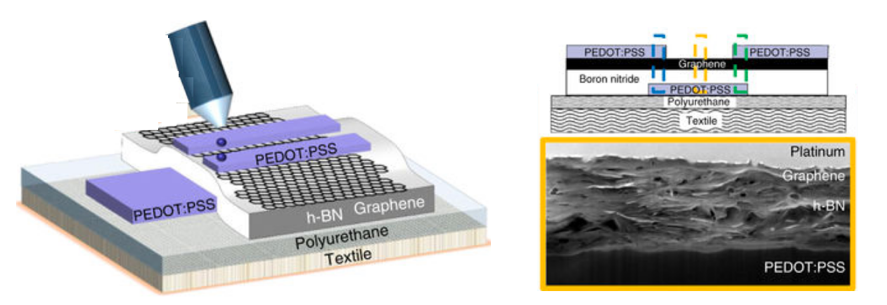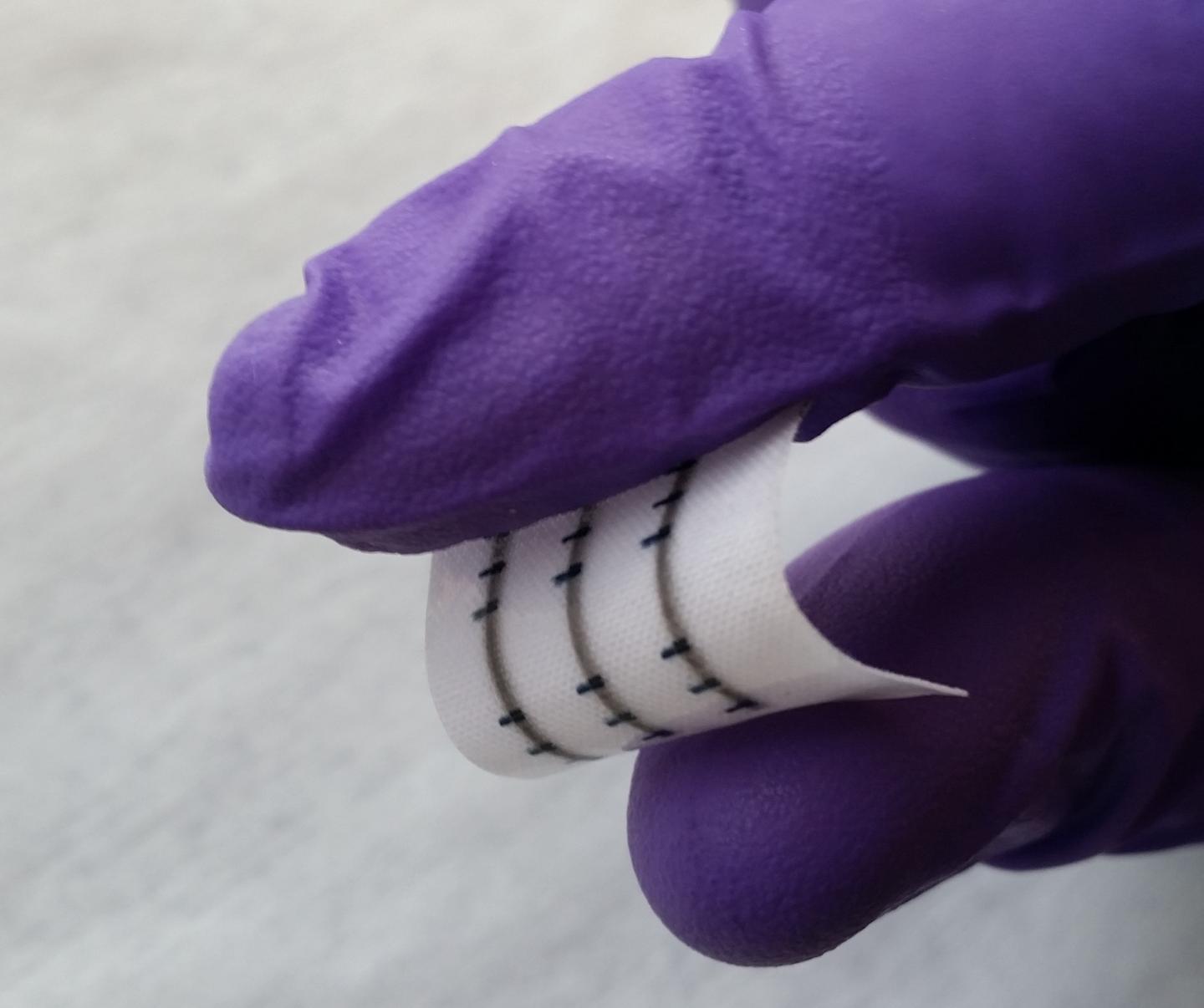Integrated circuits printed directly onto fabric for the first time
November 10, 2017
Researchers at the University of Cambridge, working with colleagues in Italy and China, have incorporated washable, stretchable, and breathable integrated electronic circuits into fabric for the first time — opening up new possibilities for smart textiles and wearable textile electronic devices.
The circuits were made with cheap, safe, and environmentally friendly inks, and printed using conventional inkjet-printing techniques.
The new method directly prints graphene inks and other two-dimensional materials on fabric to produce integrated electronic circuits that are comfortable to wear and can survive up to 20 cycles in a typical washing machine. The technology opens up new applications of smart fabrics ranging from personal health to wearable computing, military garments, fashion, and wearable energy harvesting and storage.

(Left) Final step in fabrication of an inkjet-printed field effect transistor (FET) heterostructure on textile. (Right) Side-view schematic and photo. (credit for images: Tian Carey et al./Nature Communications; composite: KurzweilAI)
Based on earlier work on the formulation of graphene inks for printed electronics, the team designed new low-boiling-point inks, allowing them to be directly printed onto polyester fabric. They also found that roughness of the fabric improved the performance of the printed devices. The versatility of this process also allowed the researchers to design all-printed integrated electronic circuits combining active and passive components.
Non-toxic, flexible, low-power, scalable
Most wearable electronic devices that are currently available rely on rigid electronic components mounted on plastic, rubber or textiles. These have limited compatibility with the skin, are damaged when washed, and are uncomfortable to wear because they are not breathable.
“Other inks for printed electronics normally require toxic solvents and are not suitable to be worn, whereas our inks are both cheap, safe and environmentally friendly, and can be combined to create electronic circuits by simply printing different two-dimensional materials on the fabric,” said Felice Torrisi, PhD, of the Cambridge Graphene Centre, senior author of a paper describing the research in the open-access journal Nature Communications.
The process is scalable and according to the researchers, there are no fundamental obstacles to the technological development of wearable electronic devices — both in terms of their complexity and performance. The printed components are flexible, washable, and require low power — essential requirements for applications in wearable electronics.
The teams at the Cambridge Graphene Centre and Politecnico di Milano are also involved in the Graphene Flagship, an EC-funded, pan-European project dedicated to bringing graphene and GRM technologies to commercial applications.
The research was supported by grants from the Graphene Flagship, the European Research Council’s Synergy Grant, The Engineering and Physical Science Research Council, The Newton Trust, the International Research Fellowship of the National Natural Science Foundation of China and the Ministry of Science and Technology of China. The technology is being commercialized by Cambridge Enterprise, the University’s commercialization arm.
Abstract of Fully inkjet-printed two-dimensional material field-effect heterojunctions for wearable and textile electronics
Fully printed wearable electronics based on two-dimensional (2D) material heterojunction structures also known as heterostructures, such as field-effect transistors, require robust and reproducible printed multi-layer stacks consisting of active channel, dielectric and conductive contact layers. Solution processing of graphite and other layered materials provides low-cost inks enabling printed electronic devices, for example by inkjet printing. However, the limited quality of the 2D-material inks, the complexity of the layered arrangement, and the lack of a dielectric 2D-material ink able to operate at room temperature, under strain and after several washing cycles has impeded the fabrication of electronic devices on textile with fully printed 2D heterostructures. Here we demonstrate fully inkjet-printed 2D-material active heterostructures with graphene and hexagonal-boron nitride (h-BN) inks, and use them to fabricate all inkjet-printed flexible and washable field-effect transistors on textile, reaching a field-effect mobility of ~91 cm2 V−1 s−1, at low voltage (<5 V). This enables fully inkjet-printed electronic circuits, such as reprogrammable volatile memory cells, complementary inverters and OR logic gates.
